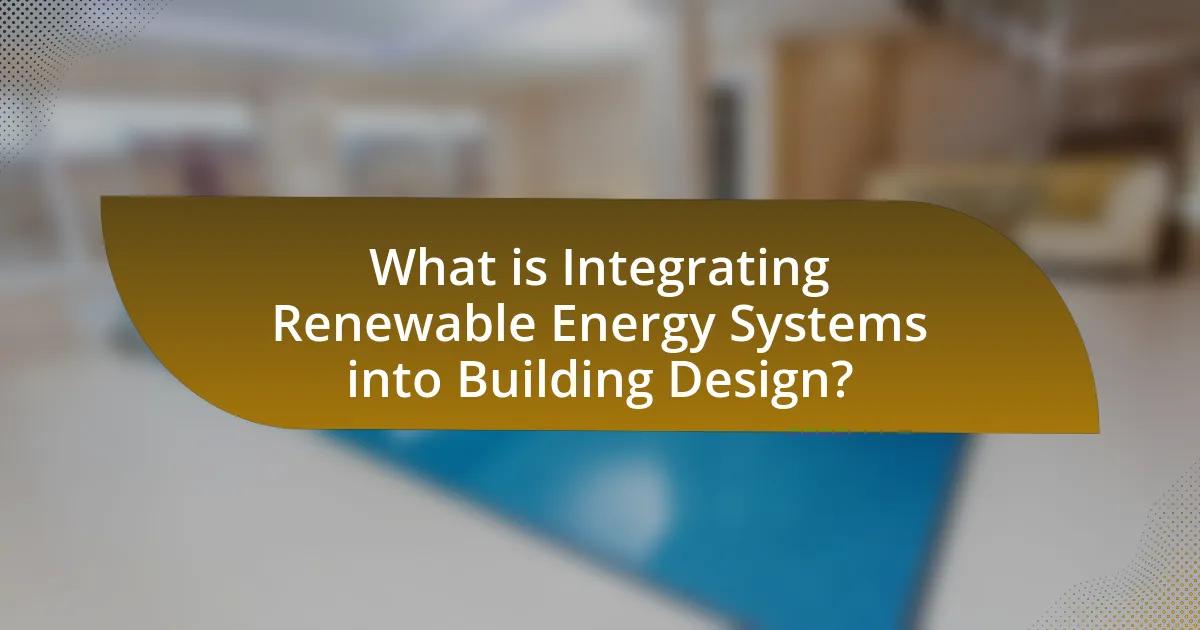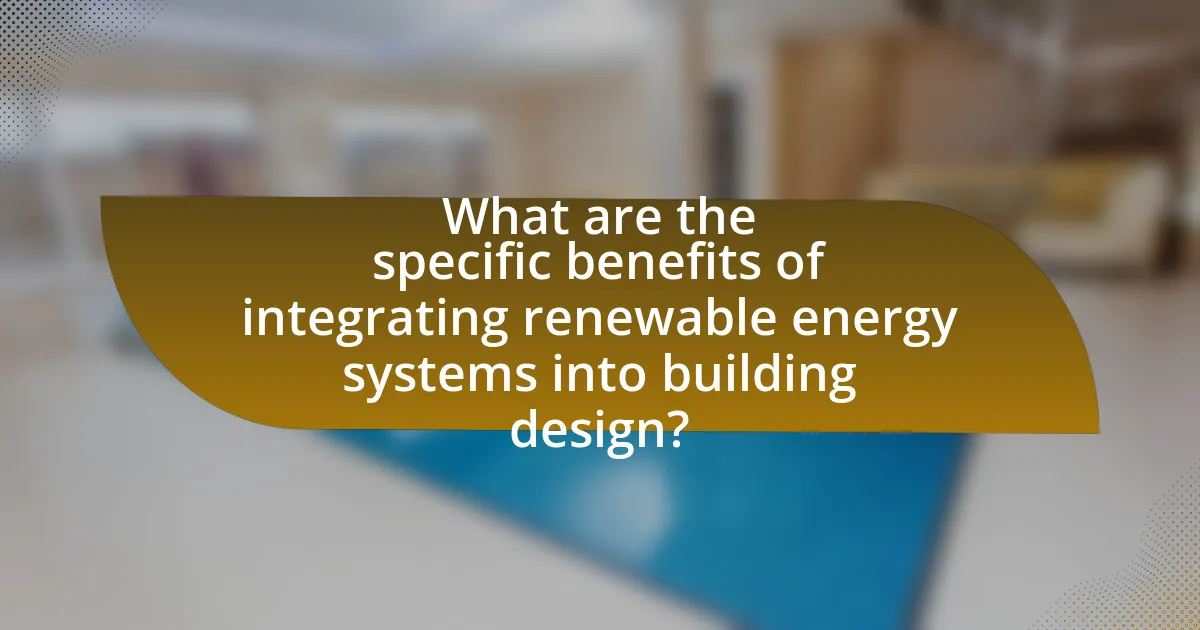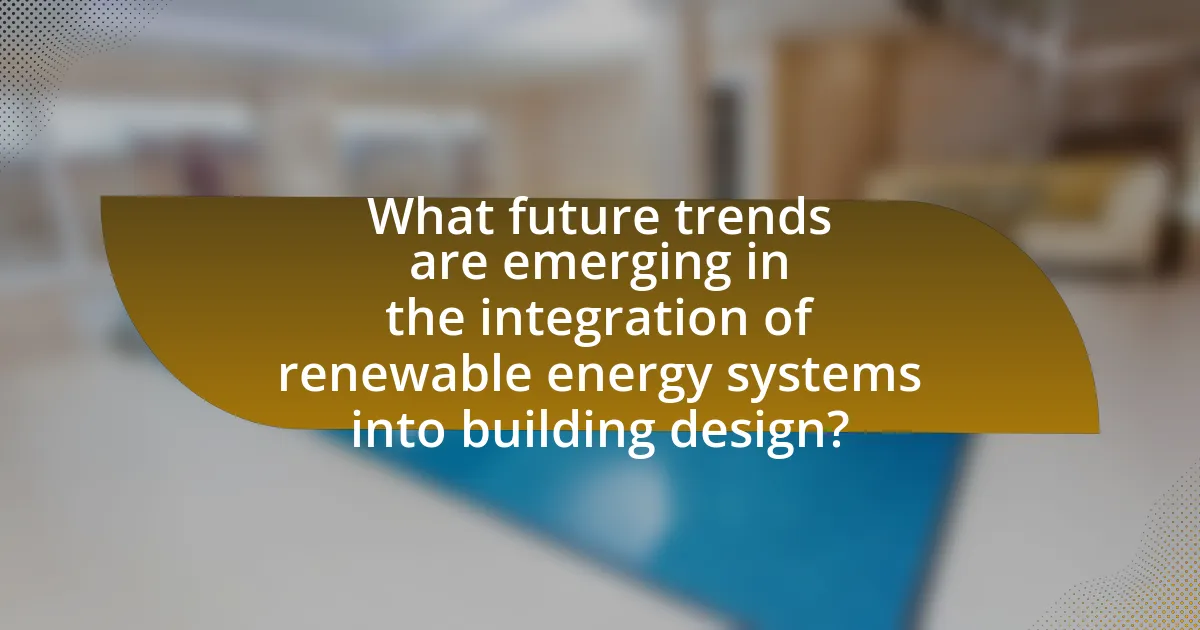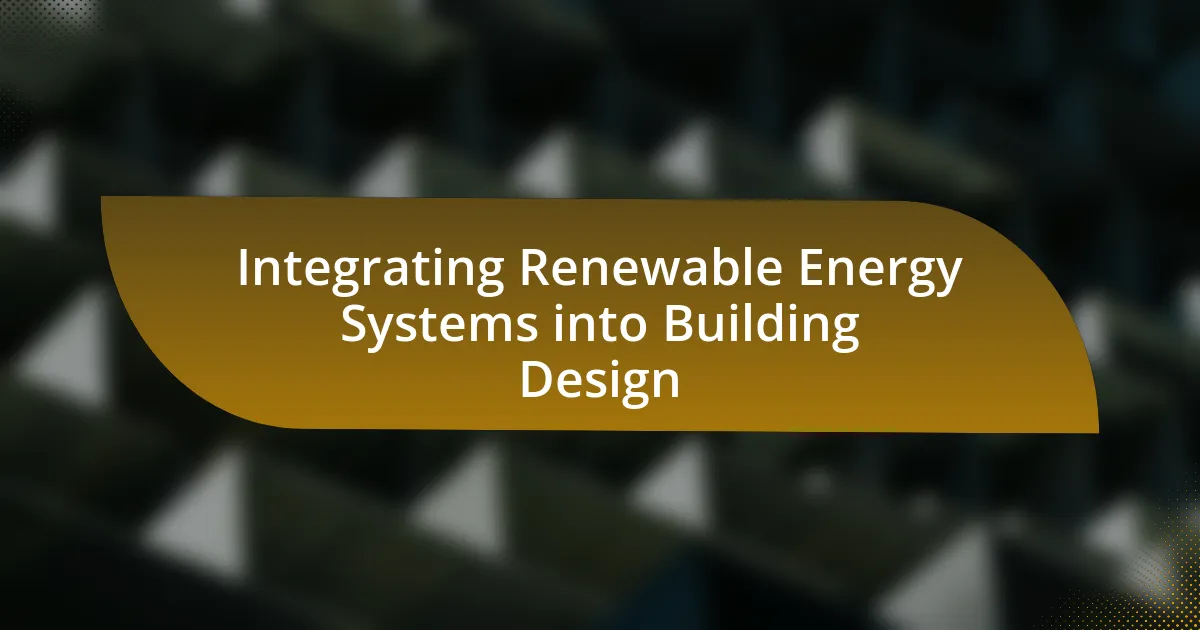Integrating renewable energy systems into building design involves the incorporation of technologies such as solar panels, wind turbines, and geothermal systems to enhance energy efficiency and reduce reliance on fossil fuels. This article outlines the various types of renewable energy systems that can be integrated, the benefits of such integration for sustainability and energy efficiency, and the challenges faced during the process. It also discusses the importance of collaboration with renewable energy experts, the role of government policies, and future trends in renewable energy technologies. Additionally, practical steps for building designers to effectively integrate these systems are highlighted, along with available resources for ongoing education and training in this field.

What is Integrating Renewable Energy Systems into Building Design?
Integrating renewable energy systems into building design involves incorporating technologies such as solar panels, wind turbines, and geothermal systems directly into the architecture and infrastructure of buildings. This integration aims to enhance energy efficiency, reduce reliance on fossil fuels, and lower greenhouse gas emissions. For instance, buildings designed with solar energy systems can generate their own electricity, contributing to a significant reduction in energy costs and environmental impact. According to the U.S. Department of Energy, buildings account for approximately 40% of total energy consumption in the United States, highlighting the importance of integrating renewable energy solutions to achieve sustainability goals.
How do renewable energy systems contribute to building design?
Renewable energy systems significantly enhance building design by improving energy efficiency and reducing environmental impact. These systems, such as solar panels, wind turbines, and geothermal heating, can be integrated into the architectural framework, allowing buildings to generate their own energy and decrease reliance on fossil fuels. For instance, buildings designed with solar energy systems can achieve up to 30% energy savings, as reported by the U.S. Department of Energy. Additionally, incorporating these systems can lead to lower operational costs and increased property value, as energy-efficient buildings are often more attractive to buyers and tenants.
What types of renewable energy systems can be integrated into buildings?
Various types of renewable energy systems can be integrated into buildings, including solar photovoltaic (PV) systems, solar thermal systems, wind turbines, geothermal heating and cooling systems, and biomass energy systems. Solar photovoltaic systems convert sunlight into electricity, making them a popular choice for residential and commercial buildings; in 2022, the U.S. installed over 20 gigawatts of solar capacity, reflecting their growing adoption. Solar thermal systems utilize sunlight to heat water for domestic use or space heating, while wind turbines can generate electricity in suitable locations, contributing to energy independence. Geothermal systems leverage the earth’s stable temperatures for heating and cooling, providing efficient climate control; the U.S. Department of Energy reports that geothermal systems can reduce energy costs by 30-60%. Lastly, biomass energy systems convert organic materials into energy, offering a renewable alternative for heating. Each of these systems can significantly reduce a building’s carbon footprint and energy costs.
How does the integration process work in building design?
The integration process in building design involves the systematic incorporation of renewable energy systems into the architectural and engineering framework of a building. This process typically begins with an assessment of the building’s energy needs and the potential renewable energy sources available, such as solar, wind, or geothermal energy.
Following the assessment, design teams collaborate to create a cohesive plan that aligns the building’s layout, orientation, and materials with the selected renewable energy systems. For instance, solar panels may be strategically placed on rooftops or facades to maximize sunlight exposure, while energy-efficient materials can be chosen to reduce overall energy consumption.
The integration process also includes the installation of necessary infrastructure, such as inverters and battery storage systems, to ensure that the renewable energy generated can be effectively utilized. This approach not only enhances the building’s sustainability but also contributes to reduced operational costs and lower carbon emissions, aligning with global efforts to combat climate change.
Why is integrating renewable energy systems important for sustainable architecture?
Integrating renewable energy systems is crucial for sustainable architecture because it significantly reduces reliance on fossil fuels and minimizes greenhouse gas emissions. By utilizing sources such as solar, wind, and geothermal energy, buildings can achieve energy efficiency and lower operational costs. For instance, according to the U.S. Department of Energy, buildings account for nearly 40% of total energy consumption in the United States, and incorporating renewable energy can lead to a substantial decrease in this figure. Furthermore, renewable energy systems enhance the resilience of buildings against energy price fluctuations and contribute to a more sustainable urban environment.
What environmental benefits arise from this integration?
Integrating renewable energy systems into building design significantly reduces greenhouse gas emissions. This integration allows buildings to generate their own energy through solar panels, wind turbines, or geothermal systems, thereby decreasing reliance on fossil fuels. For instance, a study by the U.S. Department of Energy found that buildings equipped with solar energy systems can reduce carbon dioxide emissions by up to 80% compared to traditional energy sources. Additionally, this integration promotes energy efficiency, leading to lower energy consumption and reduced environmental impact.
How does this integration impact energy efficiency in buildings?
Integrating renewable energy systems into building design significantly enhances energy efficiency by reducing reliance on non-renewable energy sources. This integration allows buildings to generate their own energy through solar panels, wind turbines, or geothermal systems, which can lead to a decrease in overall energy consumption from external grids. For instance, buildings equipped with solar photovoltaic systems can produce up to 80% of their energy needs, as demonstrated by studies showing that such systems can lower energy costs by 50% or more over time. Additionally, the use of energy-efficient technologies, such as smart grids and energy management systems, further optimizes energy use within buildings, ensuring that energy is consumed only when necessary.
What challenges are faced when integrating renewable energy systems into building design?
Integrating renewable energy systems into building design faces several challenges, including high initial costs, regulatory hurdles, and technical complexities. High initial costs can deter investment, as renewable technologies often require significant upfront capital, despite long-term savings. Regulatory hurdles arise from varying local codes and standards that can complicate the approval process for renewable installations. Technical complexities include the need for specialized knowledge to effectively integrate systems like solar panels or wind turbines into existing structures, which can lead to inefficiencies if not properly managed. These challenges can hinder the widespread adoption of renewable energy solutions in building design.
What are the technical challenges of integration?
The technical challenges of integration in the context of renewable energy systems into building design include compatibility of different energy technologies, grid connectivity issues, and the need for advanced control systems. Compatibility challenges arise when integrating solar panels, wind turbines, and energy storage systems, as these technologies often have varying operational requirements and standards. Grid connectivity issues can complicate the integration process, particularly in ensuring that renewable energy sources can effectively feed into existing electrical grids without causing instability. Additionally, advanced control systems are necessary to manage the fluctuating nature of renewable energy generation, requiring sophisticated algorithms and real-time data processing to optimize energy use and storage. These challenges are supported by studies indicating that effective integration requires addressing both technological and regulatory frameworks to ensure seamless operation and efficiency.
How do financial considerations affect the integration process?
Financial considerations significantly influence the integration process of renewable energy systems into building design by determining the feasibility and scope of the project. Budget constraints can limit the selection of technologies, as higher upfront costs may deter investment in advanced systems that offer long-term savings. For instance, a study by the National Renewable Energy Laboratory found that initial capital costs account for approximately 30-50% of the total lifecycle costs of renewable energy projects, emphasizing the importance of financial planning in decision-making. Additionally, financial incentives, such as tax credits and grants, can enhance the attractiveness of integrating renewable systems, thereby accelerating adoption rates.
How can building designers effectively integrate renewable energy systems?
Building designers can effectively integrate renewable energy systems by conducting a comprehensive site analysis to assess solar, wind, and geothermal potential. This analysis allows designers to strategically position solar panels, wind turbines, and geothermal systems to maximize energy efficiency and production. For instance, according to the U.S. Department of Energy, buildings that utilize solar energy can reduce energy costs by up to 50%. Additionally, incorporating energy-efficient designs, such as passive solar heating and natural ventilation, complements renewable systems, further enhancing overall energy performance. By utilizing advanced modeling software, designers can simulate energy flows and optimize the integration of these systems, ensuring that the building meets energy performance standards and sustainability goals.
What best practices should be followed during the design phase?
During the design phase of integrating renewable energy systems into building design, best practices include conducting a thorough site analysis, optimizing energy efficiency, and ensuring stakeholder collaboration. A comprehensive site analysis identifies solar access, wind patterns, and local climate conditions, which are crucial for effective system placement and performance. Optimizing energy efficiency involves implementing passive design strategies, such as maximizing natural light and insulation, which can significantly reduce energy demand. Furthermore, engaging stakeholders, including architects, engineers, and community members, fosters a collaborative approach that enhances the design process and ensures that the renewable energy systems meet the needs of all parties involved. These practices are supported by studies indicating that early integration of renewable energy considerations leads to more effective and sustainable building designs.
How can collaboration with renewable energy experts enhance integration?
Collaboration with renewable energy experts enhances integration by leveraging their specialized knowledge to optimize energy systems within building designs. This collaboration allows for the identification of the most efficient technologies and practices tailored to specific building needs, ensuring that renewable energy sources like solar, wind, and geothermal are effectively incorporated. For instance, studies have shown that buildings designed with input from renewable energy professionals can achieve energy savings of up to 30% compared to traditional designs, as these experts can recommend appropriate sizing, placement, and integration strategies for renewable systems.

What are the specific benefits of integrating renewable energy systems into building design?
Integrating renewable energy systems into building design offers significant benefits, including reduced energy costs, enhanced sustainability, and improved energy efficiency. These systems, such as solar panels and wind turbines, can lower utility bills by generating on-site energy, which can lead to savings of 50% or more in some cases. Additionally, buildings designed with renewable energy systems contribute to environmental sustainability by decreasing reliance on fossil fuels, thereby reducing greenhouse gas emissions. According to the U.S. Department of Energy, buildings account for nearly 40% of total energy consumption in the United States, highlighting the potential impact of integrating renewable energy solutions. Furthermore, energy-efficient designs can increase property value and attract environmentally conscious tenants or buyers, making them a smart investment in the long term.
How does this integration enhance building performance?
Integrating renewable energy systems into building design enhances building performance by significantly reducing energy consumption and operational costs. This integration allows buildings to generate their own energy through solar panels, wind turbines, or geothermal systems, leading to lower reliance on grid electricity. For instance, buildings equipped with solar photovoltaic systems can achieve energy independence, with studies showing that such systems can reduce energy bills by up to 50%. Additionally, renewable energy systems contribute to improved indoor environmental quality by minimizing emissions and pollutants associated with traditional energy sources, thus promoting occupant health and comfort.
What role does renewable energy play in reducing operational costs?
Renewable energy significantly reduces operational costs by decreasing reliance on fossil fuels and lowering energy bills. For instance, solar panels can provide a substantial portion of a building’s energy needs, leading to savings on electricity expenses. According to the U.S. Department of Energy, buildings that utilize solar energy can save between 50% to 80% on their energy costs over time. Additionally, renewable energy systems often qualify for tax incentives and rebates, further enhancing cost savings. By integrating renewable energy into building design, organizations can achieve long-term financial benefits while also contributing to sustainability efforts.
How can renewable energy systems improve occupant comfort and health?
Renewable energy systems can improve occupant comfort and health by enhancing indoor air quality and maintaining optimal thermal conditions. For instance, systems like solar panels and geothermal heating reduce reliance on fossil fuels, leading to lower emissions of indoor pollutants. Studies indicate that improved air quality can decrease respiratory issues and enhance overall well-being. Additionally, renewable energy systems often incorporate advanced ventilation strategies, which help regulate humidity and temperature, further contributing to a comfortable living environment. Research shows that buildings utilizing renewable energy sources can achieve better energy efficiency, which correlates with increased occupant satisfaction and health outcomes.
What are the long-term impacts of integrating renewable energy systems?
Integrating renewable energy systems leads to significant long-term impacts, including reduced greenhouse gas emissions, enhanced energy security, and lower energy costs. Over time, the adoption of renewable energy sources, such as solar and wind, contributes to a decrease in reliance on fossil fuels, which is evidenced by a report from the International Renewable Energy Agency (IRENA) indicating that renewable energy could reduce global CO2 emissions by up to 70% by 2050. Additionally, integrating these systems into building design promotes energy efficiency, resulting in lower operational costs for homeowners and businesses. According to the U.S. Department of Energy, buildings that utilize renewable energy can save up to 30% on energy bills compared to traditional energy sources. Furthermore, the long-term economic benefits include job creation in the renewable energy sector, with the Solar Foundation’s National Solar Jobs Census reporting over 250,000 solar jobs in the U.S. as of 2019. Overall, the integration of renewable energy systems fosters a sustainable future while providing economic and environmental advantages.
How does this integration contribute to energy independence?
Integrating renewable energy systems into building design significantly contributes to energy independence by enabling buildings to generate their own energy, reducing reliance on external energy sources. This self-sufficiency is achieved through the installation of solar panels, wind turbines, and energy-efficient technologies that harness natural resources. For instance, buildings equipped with solar photovoltaic systems can produce electricity on-site, which can cover a substantial portion of their energy needs, thereby decreasing dependence on fossil fuels and grid electricity. According to the U.S. Department of Energy, buildings account for approximately 40% of total energy consumption in the United States; thus, enhancing their energy efficiency and renewable energy generation capabilities can lead to a marked reduction in overall energy demand and increased energy autonomy.
What is the potential for increased property value through integration?
The potential for increased property value through integration of renewable energy systems into building design is significant. Properties that incorporate renewable energy technologies, such as solar panels or energy-efficient systems, often see a rise in market value due to lower utility costs and increased energy efficiency. A study by the U.S. Department of Energy found that homes with solar energy systems sold for an average of $15,000 more than comparable homes without solar. Additionally, properties with sustainable features tend to attract environmentally conscious buyers, further enhancing their market appeal and value.

What future trends are emerging in the integration of renewable energy systems into building design?
Future trends in the integration of renewable energy systems into building design include the increased use of building-integrated photovoltaics (BIPV), energy storage solutions, and smart grid technologies. BIPV systems, which combine solar energy generation with building materials, are expected to become more prevalent as they enhance aesthetics while providing energy. Energy storage technologies, such as advanced batteries, are gaining traction to optimize energy use and manage supply and demand effectively. Additionally, the integration of smart grid technologies allows for real-time energy management and enhances the efficiency of renewable energy systems in buildings. According to a report by the International Energy Agency, the global capacity of solar energy systems is projected to grow significantly, indicating a strong trend towards renewable energy adoption in building design.
How is technology advancing the integration of renewable energy systems?
Technology is advancing the integration of renewable energy systems through innovations in smart grid technology, energy storage solutions, and building management systems. Smart grids enhance the efficiency and reliability of energy distribution by enabling real-time communication between energy producers and consumers, facilitating the integration of diverse renewable sources like solar and wind. Energy storage technologies, such as lithium-ion batteries, allow for the capture and storage of excess energy generated during peak production times, ensuring a stable energy supply even when renewable sources are not actively generating power. Additionally, advanced building management systems optimize energy use within buildings by automatically adjusting energy consumption based on real-time data, further enhancing the effectiveness of renewable energy integration. These advancements collectively contribute to a more sustainable and resilient energy infrastructure.
What innovations are being developed in renewable energy technologies?
Innovations in renewable energy technologies include advancements in solar photovoltaic efficiency, energy storage solutions, and smart grid integration. For instance, researchers have developed bifacial solar panels that capture sunlight on both sides, increasing energy generation by up to 30% compared to traditional panels. Additionally, solid-state batteries are being engineered to enhance energy storage capacity and reduce charging times, which is crucial for balancing supply and demand in renewable energy systems. Furthermore, the integration of artificial intelligence in smart grids allows for real-time energy management, optimizing the distribution of renewable energy sources. These innovations are supported by ongoing research and development efforts aimed at improving the efficiency and reliability of renewable energy technologies.
How are smart building technologies influencing integration practices?
Smart building technologies are significantly influencing integration practices by enabling seamless connectivity and automation of various building systems. These technologies facilitate the integration of renewable energy sources, such as solar panels and energy storage systems, into building design, allowing for real-time monitoring and management of energy consumption. For instance, a study by the U.S. Department of Energy highlights that smart building systems can optimize energy use by up to 30%, demonstrating their effectiveness in enhancing integration practices. This optimization is achieved through advanced data analytics and IoT devices that provide actionable insights, ultimately leading to more efficient energy management and reduced operational costs.
What role do government policies play in promoting integration?
Government policies play a crucial role in promoting the integration of renewable energy systems into building design by establishing regulatory frameworks, providing financial incentives, and setting sustainability standards. These policies encourage developers and builders to adopt renewable technologies, such as solar panels and energy-efficient systems, by offering tax credits, grants, or subsidies that reduce the initial investment costs. For instance, the U.S. federal government offers the Investment Tax Credit (ITC), which allows homeowners and businesses to deduct a significant percentage of the cost of installing solar energy systems from their federal taxes. Additionally, building codes and standards, such as the International Energy Conservation Code (IECC), mandate energy efficiency measures that facilitate the incorporation of renewable energy solutions, thereby driving market demand and innovation in sustainable building practices.
How do incentives and regulations affect the adoption of renewable energy systems?
Incentives and regulations significantly enhance the adoption of renewable energy systems by providing financial support and establishing legal frameworks that encourage investment. For instance, government incentives such as tax credits, rebates, and grants lower the upfront costs associated with renewable energy installations, making them more financially viable for consumers and businesses. According to the U.S. Department of Energy, the federal Investment Tax Credit (ITC) has been instrumental in increasing solar energy adoption, contributing to a 167% growth in solar capacity from 2016 to 2020. Additionally, regulations such as renewable portfolio standards (RPS) mandate that utilities obtain a certain percentage of their energy from renewable sources, thereby driving demand for these technologies. Research by the International Renewable Energy Agency (IRENA) indicates that countries with strong regulatory frameworks and incentives see higher rates of renewable energy deployment, demonstrating the critical role these factors play in facilitating the transition to sustainable energy systems.
What future policies could enhance integration efforts?
Future policies that could enhance integration efforts of renewable energy systems into building design include implementing mandatory building codes that require the incorporation of renewable technologies, such as solar panels and energy-efficient systems, in new constructions. These codes can drive innovation and standardization in design practices, ensuring that buildings are not only energy-efficient but also capable of generating their own energy.
Additionally, providing financial incentives, such as tax credits or grants for developers and homeowners who adopt renewable energy solutions, can significantly increase adoption rates. For instance, the U.S. federal solar tax credit has historically led to a substantial increase in solar installations, demonstrating the effectiveness of financial incentives in promoting renewable energy integration.
Furthermore, establishing public-private partnerships can facilitate research and development of new technologies that enhance integration, ensuring that the latest advancements are accessible and applicable in building design. These collaborative efforts can lead to the creation of more efficient systems that are tailored to specific building needs and local climates.
Overall, these policies can create a supportive framework that encourages the widespread adoption of renewable energy systems in building design, ultimately contributing to sustainability goals and reducing carbon footprints.
What practical steps can building designers take to integrate renewable energy systems effectively?
Building designers can effectively integrate renewable energy systems by conducting a comprehensive site analysis to assess solar, wind, and geothermal potential. This analysis allows designers to optimize the placement of solar panels, wind turbines, and geothermal systems based on environmental conditions. Additionally, incorporating energy-efficient building materials and designs, such as passive solar heating and high-performance insulation, enhances the effectiveness of renewable systems by reducing overall energy demand.
Furthermore, designers should engage in early collaboration with renewable energy specialists to ensure that systems are compatible with the building’s architecture and intended use. Implementing smart energy management systems can also facilitate the integration of renewable sources by optimizing energy consumption and storage. According to the U.S. Department of Energy, buildings that utilize renewable energy systems can reduce energy costs by up to 50%, demonstrating the financial viability of these practical steps.
What resources are available for building designers to learn about integration?
Building designers can access various resources to learn about integration, particularly in the context of renewable energy systems. Key resources include online courses from platforms like Coursera and edX, which offer specialized programs on sustainable design and energy integration. Additionally, industry publications such as the “Journal of Building Performance” provide peer-reviewed articles on the latest research and case studies in building integration. Professional organizations like the American Institute of Architects (AIA) and the International Living Future Institute also offer workshops, webinars, and certification programs focused on integrating renewable energy into building design. These resources are validated by their widespread use in educational and professional settings, ensuring that designers are equipped with current knowledge and best practices.
How can ongoing education and training improve integration outcomes?
Ongoing education and training can significantly improve integration outcomes by equipping professionals with the latest knowledge and skills necessary for effectively incorporating renewable energy systems into building design. Continuous learning ensures that architects, engineers, and construction teams stay updated on advancements in technology, regulatory changes, and best practices, which are crucial for optimizing energy efficiency and sustainability. For instance, a study by the National Renewable Energy Laboratory found that training programs focused on renewable energy technologies led to a 30% increase in successful project implementations. This evidence highlights that ongoing education directly correlates with enhanced integration capabilities, ultimately resulting in more effective and sustainable building designs.
